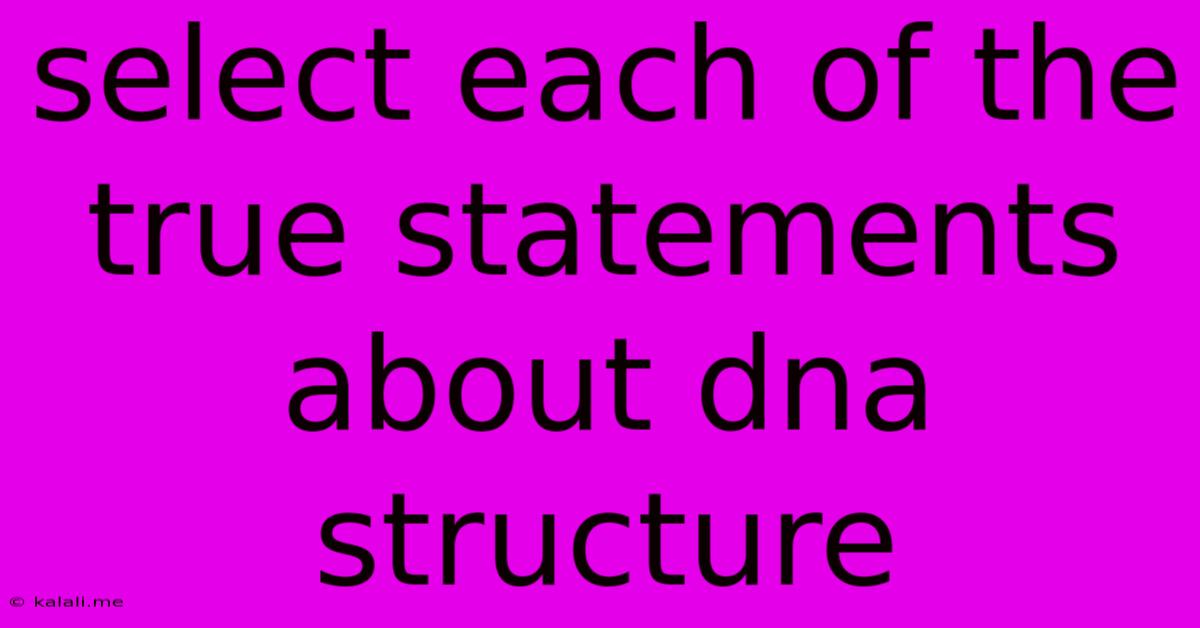Select Each Of The True Statements About Dna Structure
Kalali
Jun 15, 2025 · 3 min read

Table of Contents
Select Each of the True Statements About DNA Structure: A Comprehensive Guide
DNA, the blueprint of life, is a fascinating molecule with a remarkably elegant structure. Understanding its intricacies is crucial for grasping the fundamentals of genetics and molecular biology. This article explores the key features of DNA structure, clarifying common misconceptions and highlighting the true statements about its composition and organization. This guide will help you confidently select the correct statements regarding DNA's structure on any quiz or exam.
DNA is a double-stranded helix composed of nucleotides. Each nucleotide consists of a deoxyribose sugar, a phosphate group, and one of four nitrogenous bases: adenine (A), guanine (G), cytosine (C), and thymine (T). The structure is stabilized by hydrogen bonds between complementary base pairs and hydrophobic interactions within the helix. Understanding these components and their interactions is key to grasping the true statements about DNA structure.
Key Features of DNA Structure: True Statements Explained
Here's a breakdown of true statements regarding DNA structure, explained in detail:
-
DNA is a double helix: This is a fundamental characteristic. The two strands wind around each other to form a helical structure, resembling a twisted ladder. This double-stranded nature is essential for DNA replication and the preservation of genetic information.
-
The strands are antiparallel: The two strands run in opposite directions. One strand runs 5' to 3', while the other runs 3' to 5'. This antiparallel arrangement is crucial for DNA replication and transcription. The 5' and 3' designations refer to the carbon atoms in the deoxyribose sugar.
-
Adenine pairs with thymine, and guanine pairs with cytosine: This base pairing is a cornerstone of DNA's structure. Adenine (A) forms two hydrogen bonds with thymine (T), while guanine (G) forms three hydrogen bonds with cytosine (C). This specific pairing ensures the consistent width of the DNA double helix and is essential for accurate replication.
-
The sugar-phosphate backbone is on the outside, and the bases are on the inside: The deoxyribose sugar and phosphate groups form the backbone of the DNA molecule, located on the exterior of the helix. The nitrogenous bases are stacked inside, interacting through hydrogen bonding. This arrangement protects the genetic information encoded by the bases from damage.
-
DNA is a polymer of nucleotides: DNA is a long chain-like molecule made up of many repeating units called nucleotides. These nucleotides are joined together by phosphodiester bonds, forming a continuous sugar-phosphate backbone.
Statements that are Often Misunderstood or Incorrect:
To further solidify your understanding, let's address some common misconceptions:
-
DNA is always a right-handed helix: While the B-DNA form, the most common form, is a right-handed helix, other forms exist, including the left-handed Z-DNA.
-
The DNA helix has a uniform diameter: While the base pairing ensures relatively uniform width, slight variations can occur depending on the specific sequence and DNA conformation.
-
The number of hydrogen bonds is the only factor determining base pairing stability: While hydrogen bonds are crucial, hydrophobic interactions and stacking forces between the bases also contribute to the overall stability of the DNA double helix.
By understanding the true statements about DNA structure and distinguishing them from common misconceptions, you'll build a solid foundation in molecular biology. Remember, the specific arrangement of these components allows for DNA replication, transcription, and translation – the fundamental processes of life.
Latest Posts
Latest Posts
-
1 Electron Volt Is Equivalent To
Jun 15, 2025
-
Which Graph Represents A Nonlinear Relationship
Jun 15, 2025
-
Abnormal Hardening Of Bone Is Known As
Jun 15, 2025
-
What Are The Factors For 74
Jun 15, 2025
-
What Is The Lcm Of 3 6 And 9
Jun 15, 2025
Related Post
Thank you for visiting our website which covers about Select Each Of The True Statements About Dna Structure . We hope the information provided has been useful to you. Feel free to contact us if you have any questions or need further assistance. See you next time and don't miss to bookmark.